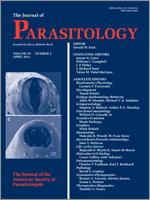Parapharyngodon bainae n. sp. (Nematoda: Pharyngodonidae) collected from the small intestine of Tropidurus torquatus (Squamata: Tropiduridae) is described. The new species is the 47th species in the genus and the 14th in the Neotropical region. The morphology of male posterior end, ovary position in females, and egg size can be used to differentiate P. bainae from the other congeneric species. Parapharyngodon rotundatus, Parapharyngodon sanisfaciecaudus, and Parapharyngodon riojensis are most closely related to P. bainae. In males of P. sanisfaciecaudus and P. rotundatus, the cloacal lip has a smooth appearance, whereas in P. bainae, males have an echinate cloacal lip. Parapharyngodon riojensis differs from P. bainae because its females have postbulbar ovaries, the eggs are larger, and the esophagi are larger in both sexes. Parapharyngodon spp. nematodes occupy an intermediate phylogenetic position among pharyngodonid parasite lineages in carnivorous and herbivorous reptiles. The average low intensity of infection for P. bainae (4.8 ± 4.6) is typically found in carnivorous reptiles. This fact and the high prevalence value (60%) can be explained by the ingestion of environmental substrata material containing parasite eggs while foraging.
How to translate text using browser tools
1 April 2011
A New Species of Pharyngodonidae (Nematoda) of Tropidurus torquatus (Squamata: Tropiduridae) from Brazil
Felipe B. Pereira,
Bernadete M. Sousa,
Sueli de Souza Lima
ACCESS THE FULL ARTICLE

Journal of Parasitology
Vol. 97 • No. 2
April 2011
Vol. 97 • No. 2
April 2011




